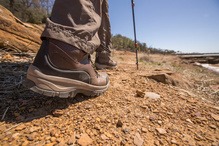There is nothing like pitching a tent in the cold. The ground is frozen so pounding in tent stakes is somewhat of a challenge. It would be even worst in a blinding snowstorm, but luckily for us, there was no blizzard. Four intrepid young men and five adults braved the cold in Miller canyon over the last weekend from January 26th-28th.
Each year dozens of people in America find themselves in an unexpected outdoor emergency. They get lost, injured, or stranded and suddenly find themselves depending upon survival skills to survive. If you have a phone or two-way radio with reception, the stay may be short, like a two- or three-hour adventure. However, for some who not make the necessary precautions or do not survival skills, their adventure can end in tragedy This is where the application of the techniques in the Wilderness Survival Merit Badge come in not only handy, but can be a life changer in an emergency.

We arrived on site around 6 PM and settled into camp the first night. The temperature was a chilly 24% by the time everybody turned in for the night. The next day after breakfast Burritos, a camp favorite, the boys began working on their survival skills in earnest. After what I call the classroom portion of the requirements (explain the hazards, what would you do in this situation, etc.) the scouts settled into the hands-on portion of learning and demonstrating how to do the important skills such, the three methods of how to build a fire without the modern convenience of matches or lighters. There are several ways to start a fire that does not require either matches or a lighter. As we all know, fire is a survival essential, whether it be for warmth, cooking, or signaling. Unless you plan ahead and ensure that you have a proper survival bag with you and have stocked a lot of fine modern devices for starting a fire, among other things, you may need to rely on an alternative method of fire-starting. After all, you only need to start with a small flame to reach a raging inferno. Having said that, keep it in mind, from a safety standpoint.
Most fires can only be started in three ways, Fire from fire, fire from friction, and fire from a lens. Fire from fire is self-explanatory, using and ember from a burning source, but the most common way is from matches or a lighter. Since we are lost and trying to stay alive, let’s concentrate on the other two methods.
Fire from Friction is the hardest method and not for the faint of heart. You surely have heard of the hand drill with a stick and a board of Indian lore. Set the stick on top of the board and spin it back and forth. Enough friction will give you a burning ember. Cottonwood, juniper, aspen, willow, cedar, cypress, and walnut make the best fire-board and spindle sets. A different version is to make a bow from a stick and some string, rope, or other strip of fabric or other item and then use the bow to spin the stick. Either way is tiring and will take quite a while to get the kindling hot enough to burn.
Flint and steel, such as a knife and a Ferrous rod make a good idea and are easy to carry around for use in a pinch.
Lens Based methods incorporate traditional lenses such as magnifying glasses, prescription glasses as well as anything that can concentrate light such as water bottles, balloons, and even condoms. Remember that before you leave a water bottle in your car where the sun can get to it. You may come back and find your car burned to the ground, by the fire started from focused light through a water bottle. Ever heard of the expression “fire from ice?” It actually works. Just shape the clear ice into a lens shape. Great for frozen areas.
Another interesting technique involves chocolate and a soda can. Coat the bottom of the can with chocolate by rubbing it on the bottom of a soda can. It acts like a polish and the can bottom will shine. Use it like a parabolic mirror and you can focus sunlight just like with a normal lens.
If you have any items with you that have batteries in them, you can use the them together with steel wool to start a fire. Any battery will do, but 9-volt batteries work best since the positive and negative contacts are on the same side.
They also learned how to signal or attract attention using smoke, light, rocks and wood. Water is also another necessity so the scouts have to demonstrate how to filter water using survival methods. Shelter was the last objective so, for the grand finale, the scouts had to improvise and then sleep in a natural shelter of their own design, while minimizing the impact on the environment.
All in all, the scouts passed with flying colors, some a might colder than others, but all enjoying their adventure after all, safe in the knowledge they can survival in an emergency.
As Always, Be Prepared!

Sources:
The Pocket Outdoor Survival Guide, J. Wayne Fears, 2011, Sky Horse Publishing
The SERE Survival Handbook, 2022, Mentor Enterprises Inc.
SAS Survival Handbook, John Wiseman, 2014, William Morrow, Harper Collins







